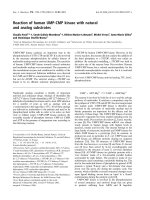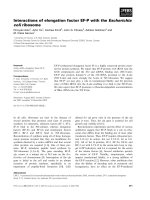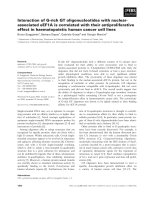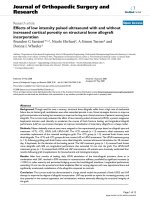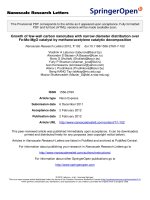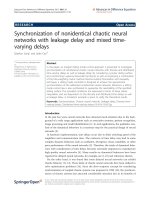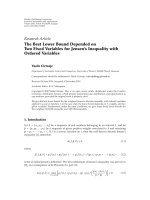Báo cáo khao học: "Dominance of the mycorrhizal fungus Rhizopogon rubescens in a plantation of Pinus pinea seedlings inoculated with Suillus collinitus" ppsx
Bạn đang xem bản rút gọn của tài liệu. Xem và tải ngay bản đầy đủ của tài liệu tại đây (115.46 KB, 8 trang )
K. El Karkouri et al.Dominance of R. rubescens in a P. pinea plantation
Original article
Dominance of the mycorrhizal fungus
Rhizopogon rubescens in a plantation of Pinus pinea
seedlings inoculated with Suillus collinitus
Khalid El Karkouri
a
, Francis Martin
b
and Daniel Mousain
a
*
a
Laboratoire de Recherches sur les Symbiotes des Racines
**
, Institut National de la Recherche Agronomique,
AgroM-INRA, 2 Place Viala, 34060 Montpellier Cedex 1, France
b
Unité Mixte de Recherche INRA-UHP Interactions Arbres / Micro-organismes, Centre INRA de Nancy,
54280 Champenoux, France
(Received 15 January 2001; accepted 28 June 2001)
Abstract – We examined the below-ground mycorrhizal diversity of P. pinea seedlings inoculated with S. collinitus six years after out-
planting in a disturbed site, located at La Petite-Camargue (Gard, France). This was performed using the polymerase chain reaction
(PCR), the restriction fragment length polymorphism (RFLP) and the sequencing of the nuclear ribosomal internal transcribed spacer
(ITS). Seven and one plants corresponding, respectively, to inoculated and non-inoculated (control) treatments were chosen randomly.
Examinations were carried out directly from ectomycorrhizae. A total number of 233 root tips was examined. Five ITS RFLP taxa were
detected. The ITS taxon I corresponded to the ectomycorrhizal species Rhizopogon rubescens. This fungus was abundant (55%) in the
P. pinea ectomycorrhizal community. Theother ITS taxa were rareandremained unidentified. The current P. pineaplantation showed a
restricted diversity of the ectomycorrhizalcommunitywhichistypical of ectomycorrhizal communities in young plantations established
in disturbed stands.
Pinus pinea L. / plantation / ectomycorrhizal diversity / PCR-RFLP / rDNA (ITS)
Résumé – Dominance de l’espèce mycorhizienne R. rubescens dans une plantation à Pinus pinea. La diversité ectomycorhizienne
de plants de P. pinea, inoculés par S. collinitus, a été examinée six années après transplantation dans un site perturbé de La Petite-Ca-
margue (Gard, France).L’identification de cette diversitéfongique a été effectuéeà partir de l’espaceurinterne transcrit (ITS) del’acide
désoxyribonucléique (ADN) nucléaire et ribosomal. Deux marqueurs moléculaires dérivés de la réactiondepolyméraseenchaîne(PCR)
ont été utilisés : le polymorphisme de fragments de restriction (RFLP) et le séquençage des produits d’amplification de l’ADN. Sept et
un plants correspondant, respectivement, aux plants inoculés et non inoculés (témoin) ont étéchoisis au hasard.Le typage moléculaire a
été réalisé directement à partir des ectomycorhizes. Deux cent trente trois racines courtes mycorhizées ou non ont été examinées. Cinq
types d’ITSRFLP ont été détectés. Le type I correspond à l’espèce ectomycorhizienne Rhizopogon rubescens. Cette dernière, est domi-
nante (55 %) dans la communauté ectomycorhiziennedecetteplantation.Les autres types d’ITS RFLP ont été rares etrestentnonidenti-
fiés. La plantation de P. pinea a montré une faible diversité ectomycorhizienne qui est typique des communautés ectomycorhiziennes
des jeunes plantations établies dans des sites perturbés.
Pinus pinea L. / plantation / diversité ectomycorhizienne / PCR-RFLP / ADNr (ITS)
Ann. For. Sci. 59 (2002) 197–204
197
© INRA, EDP Sciences, 2002
DOI: 10.1051/forest:2002006
* Correspondence and reprints
Tel. 04 99 61 24 53; Fax. 04 67 54 57 08; e-mail:
** Present address: Unité Mixte de Recherche INRA-ENSAM Sol et Environnement, Équipe Rhizosphère et Symbioses.
1. INTRODUCTION
In natural ecosystems, roots of forest trees live in as-
sociation with below-ground soil-born fungal communi-
ties and populations forming symbiotic structures called
ectomycorrhizae (ECM) [11]. The ectomycorrhizal my-
celium of these symbiotic organs grows and develops or
not fruit bodies above the ground. The ectomycorrhizal
symbiosis is known to improve the mineral nutrition, the
growth and the adaptation of forest trees. Ectomycorrhizal
fungi have thus been exploited in many reforestation
programmes (for a review see [17, 18]). However,
knowledge of the structure and the composition of the
ectomycorrhizal fungal communities (EFCs) of the
young plantations is still limited [10, 22]. In addition,
comparing to the number of recent reports performed on
the analysis of the EFCs from mature forests [e.g. 4, 5, 8,
13, 14, 23, 24], information on the EFCs in the young
plantations and in the young stands [3, 24] and their rela-
tionships with those of the mature forests are rare.
In the Mediterranean region, the deterioration of for-
ests and its consequences on soil conservation and the
stress accompanying the outplanting of young forest
trees are often related to the drastic edaphic and climatic
conditions. Indeed, for example in the region of “La Pe-
tite-Camargue” (Gard, France), the Brasinvert’s domain
of approximately 200 hectares of calcareous arenosol
was subjected to ecological disturbances (violent storms
and drought stress) before 1983, leading to the death of
90% of mature Pinus pinea trees between 1983 and 1986
[2]. After that disturbance, an experimental plantation
was established in the domain in 1990 with nursery-non-
inoculated and– inoculated with S. collinitus Pinus pinea
seedlings [2].
The present investigation examined the diversity of
below-ground P.pinea EFC sixyears afteroutplanting in
this disturbed site. This wasperformed using PCR-RFLP
and sequencing of the rDNA ITS directly from the
ectomycorrhizal root tips.
2. MATERIALS AND METHODS
2.1. The experimental plantation of P. pinea
The description of the experimental P. pinea planta-
tion in the Brasinvert’s domain (latitude: 43
o
28’ 12";
longitude: 4
o
18’ 52"; altitude: 1 m) was detailedby [2].
Two treatments were carried out: seedlings inoculated
with S. collinitus (J 3.15.2) and non-inoculated (= con-
trol) seedlings. This fungus was collected under a 20-
year-old P. pinea plantation in a calcareous arenosol site
at “La Grande-Motte” (south of France) in 1985. It was
also distinguished from other Suillus spp. [16] and from
other S. collinitus strains [6] using ITS sequence and
isozyme analysis, respectively. Each treatment was sub-
jected to a fertilization with a liquid fertilizer (formula 8-
6.5-13, Dynaflor
, Sète, France) diluted at 0.5% (D), a
fertilization with the same solution at 0.1% (D/5) and no
fertilization (NF) in the nursery. The inoculated and the
control P. pinea seedlings were introduced in three ran-
domized complete plots (I, II and III) in the plantation in
January 1990.Only 55plants of plot III (36 m × 24 m) in-
oculated with S. collinitus (J 3.15.2) and the correspond-
ing 14 control plants, all fertilized with the D/5 solution,
were considered for further sampling and DNA typing.
The inoculated and the control treatments were distrib-
uted in three and two lines of plants, respectively. The
two treatments, the lines and the plants were 9, 3 and
1.5 m apart, respectively.
2.2. Sampling plants, roots and ECM
Soil was carefully removed starting near the base of
the plant stem until the roots appear. Digging was then
carefully continued in a centrifugal direction to the end
of the long roots of 0.97– 2.3 m of length. No abundant
roots and young mycorrhizal morphotypes were ob-
served during root and ECM surveys. Two types of ECM
were found: young ECM with well developed mantle
and old ECM associated to dried black roots and having
either no mantle or a naturally damaged mantle. A total
of eightplants corresponding to 12.7% and7% ofrespec-
tively inoculated and control treatments were examined
randomly (table I). The inoculated treatment was exam-
ined in both Spring and Autumn 1996 (i.e. six years after
outplanting), while control treatment was examined in
Spring of the same year. Nearly all the roots (4 to 9 per
plant) and all the young ECM observed were sampled,
while the old ECM were chosen randomly. Both roots
and ECM were found at 10–30 cm of soil depth. How-
ever, prior to excising the root tips, the root systems were
carefully washed to remove most of the adhering soil
substrates. A total of 233 ECM (9 to 53 per plant) were
taken (140 young ECM, 91 old ECM and two short roots
– which seemed non-mycorrhizal) using a binocular mi-
croscope (table I). They were then washed once with
H
2
O
2
during 30 seconds and then three times with
autoclaved H
2
O, and stored at –70
o
C for further DNA
198 K. El Karkouri et al.
extraction and molecular analysis of the P. pinea EFC.
The sampling approach described above presents three
advantages: the plants were not completely removed
from the soil, the plantation was less damaged, and links
between the roots and the plants were ascertained.
2.3. DNA extraction and PCR amplification
Total DNA was extracted from the fresh vegetative
mycelia andfrom the single ECM usingthe CTABproto-
col [7,12]. The nuclear rDNA internal transcribed spacer
(ITS = 3’end of 18S + ITS1 + 5.8S + ITS2 + 5’end of
25S) wasamplified by PCRusing ITS1 and ITS4 primers
[25]. The amplification reaction consisted of a total vol-
ume of50 µL.The first 25 µL corresponded to the diluted
total DNA (1/100, 1/125 or 1/250) of the mycelium, or
(1/2.5, 1/5, 1/10 and 1/15) of the root tips. The second
volume correspondedto a PCRmixture adjusted to25 µL
with deionized water (MilliQ). The reagents of the PCR
reaction and their final concentrations were: 20 mM
Tris-HCl (pH 8.4), 50 mM KCl, 2.5 mM MgCl
2
, 0.05%
W-1 (GibcoBRL, Life Technologies), 200 mM each of
ultrapure dATP, dCTP, dGTP and dTTP (Pharmacia
Biotech), 0.2 mM each of the two primers (Eurogentec,
Belgium) and 1.75 units Taq DNA polymerase
(GibcoBRL, Life Technologies) [12]. The PCR cycles
were ensued according to [7] using a PTC-100
thermocycler (MJ Research, Inc., Watertown, MA,
USA). Negative controls (no DNA template) were made
in all PCR experiments to check DNA contamination of
reaction mixtures. The pUCBM21 DNA (molecular
weight marker VIII, Boehringer Mannheim), cleaved
with HpaII and DraI plus HindIII was used as size stan-
dards. Size of the PCR and RFLP fragments were deter-
mined using the ImageMaster 1D Gel Analysis (v 3.0)
programme (Amersham Pharmacia Biotech). For RFLP
analysis, thenon reproduciblebands withsize lowerthan
67 bp were not considered.
2.4. RFLP analysis
Ten microliters of ITS products were mixed with
1.5 µL of the React mix, containing 5 units eachof HinfI,
AluI, MspI, CfoI, and RsaI (GibcoBRL, Life Technol-
ogies), and adjusted to 15 µL with deionized water ac-
cording to the manufacturer’s recommendations. The
amplified products and the restriction fragments
(RFLPs) were electrophoresed on 1.5% and on 2% high
Dominance of R. rubescens in a P. pinea plantation 199
Table I. Number of plantsand ECM examinedand results ofthe successful PCR-ITSamplification and ITS-RFLPtypes obtained inthe
P. pinea plantation.
Seasons Total of PCR of Y. ECM ITS-RFLP types
& plants ECM [O. Y. ] T [s d t ] I II III IV V
Spring
C1/L2 28
1
[620] 12[1200] 00750
I2/L2 22 [19 3 ] 3 [1 2 0 ] 10002
Autumn
I1/L1 20 [0 20] 17 [17 0 0 ] 11 0600
I2/L1 35 [13 22] 21 [8 12 1 ] 0 10 0 0 11
I3/L2 21 [12 9 ] 9 [0 9 0 ] 90000
I4/L2 9 [5 4 ] 0 [0 0 0 ] 00000
I5/L2 45 [23 22] 17 [3 14 0 ] 17 0000
I6/L2 53 [13 40] 39 [0 39 0 ] 39 0000
Total 233 [91 140] 118 [41 76 1 ] 77 10 13 5 13
ECM: ectomycorrhizae. O.: old. Y.: young.
C and I: control and inoculated plants, respectively, with their corresponding numbers and lines (L) in the plot.
T [s, d, t]: total of successful PCR amplifications [single, double, triple amplified DNA bands].
1
Two short roots which seemed non-ectomycorrhizal were included.
resolution agarose gel (Sigma), respectively, stained
with ethidium bromide, and photographed under ultravi-
olet light using the Imager 2.02, a system including a mi-
cro-computer incorporating an image processing
software v. 2.02 related to an UV cabinet by a CDD cam-
era (Oncor-Appligene).
2.5. ITS sequencing
The sequencing reactions were performed on the am-
plified ITS of mycelia and some representative ECM
(No. 125, 18, TQ & TU) showing single ITS products.
The double stranded ITS products were then purified us-
ing the QIAquick PCR purification Kit (Quiagen) in ac-
cordance with the manufacturer’s instructions. Both
strands were sequencedseparately using theBigDye Ter-
minator Cycle Sequencing Kit, the AmpliTaq DNA
Polymerase FS (Perkin Elmer Applied Biosystems, Fos-
ter, City, CA, USA) and the ITS1 or ITS4 primers. Se-
quencing products were analysed using the automated
ABI PRISM 310 DNA Genetic Analyser (Perkin Elmer
Applied Biosystems) at the DNA Sequencing Facilities
of INRA-Nancy (France). The sequencing data were ed-
ited using Sequencher (Genes Codes Corporation, Ann
Arbor, MI, USA) for Macintosh computers.
2.6. Molecular identification of ECM
Each “ITS RFLP-type” corresponding to a pool of
ECM was named “ITS RFLP-taxon”. To identify these
taxa, the ITS RFLP patterns and the ITS sequences were
compared with referenced ITS RFLP patterns of
ectomycorrhizal species, and with GenBank ITS se-
quence database, respectively. ITS sequences were then
deposited in theGenBankdatabase. The determinationof
the taxa having the closest sequence was performed by
DNA sequence comparison using the Blastn program at
the National Center for Biotechnology Information.
3. RESULTS
Amplification yield of the fungal ITS of the
140 young ECM was high (84%) (table I). In contrast,
the old ECM and the short roots of P. pinea did not pro-
duce any PCR products. The lack of PCR products with
the old ECM likely resulted from the presence ofenzyme
inhibitors and/or to the poor quality of these ECM (dry
roots without mantle or with a naturally damaged man-
tle). Therefore, only young ECM were considered in the
subsequent calculations. The amplification products of
the young ECM showed either single (29%), double
(54%) or triple (approx. 1%) ITS bands, suggesting the
presence of fungal contaminants in most mycorrhizal
roots. The additional bands showed a low intensity and
thus did notaffect the analysis.The absence ofacommon
ITS product in the 233 mycorrhizal root tips indicated
that there was no amplification of the P. pinea ITS.
3.1. Identification and frequency of the ITS RFLP
taxa
The size of the PCR products ranged from 600 to
740 bp. The digestion of the ITS products of the young
200 K. El Karkouri et al.
Table II. Sizes of the restriction fragments of the amplified ITS of the vegetative mycelia of Suillus collinitus and Rhizopogon
rubescens and the four ITS-types detected in the plantation.
Taxa & Uncut ITS and ITS-RFLPs (sizes in bp)
ITS types ITS HinfI AluI MspI CfoI* RsaI*
S. collinitus (J 3.15.2) 698 186/136/114/93/86 635/81 410/154/89 351/332 706
R. rubescens (R 19.1) 726 215/192/126/112 384/258 468/241 363/162/135 733
I 737 212/190/135/112 384/258 468/241 367/165/137 743
II 616 267/208/92 524/65 425/127 301/275/162 621
III 603 264/196/89 508/87 405/115 301/155/115 583
IV 637 270/147 628 216/170/102 207/137/124 488/106
* CfoI andRsaI were used to digesttheITSproductsof only 4 representativeECM(No. 125,18,TQ & TU)corresponding to the4 ITS-RFLP types(I, II, III
& IV), respectively. ITS-type V was not determined because it showed restriction digests from a double ITS amplification.
ECM with HinfI, AluI and MspI yielded five ITS RFLP
types (I to V) (table I). The sizes of the RFLPs, excepted
the ITS V where all ECM showed double amplified ITS
products, are given in table II. Type I was similar to
the RFLP pattern of R. rubescens (R 19.1) (table II and
figure 1, lanes 2 and 3). The ITS sequences of R. rubescens
(R 19.1) (EMBL accession # AJ277644) and ECM 125
(type I) (EMBL accession # AJ277645) exhibited 96%
and 94% homology with the R. rubescens ITS sequence
present in the database (GenBank accession # AF158018)
[23] (figure 2). This species was the dominant (55%)
mycorrhizal symbiont on most inoculated plants sam-
pled, at distances ranging from 4 to 21.6 m in the plot.
None of the other ITS types (II to V) showed aRFLP pat-
tern similar to ITS RFLP patterns of reference strains
which included six Suillus species (e.g. S. collinitus, fig-
ure 1), Thelephora terrestris and Cenococcum geophilum.
The ITS sequences of types II (ECM 18), III (ECM TQ)
and IV (ECM TU) did not correspond to any
ectomycorrhizal fungi in the GenBank ITS sequence da-
tabase. In contrast to the dominant R. rubescens
mycorrhizal type, the four other ITS types were detected
at a low rate (4 to 9%), in no more than two plants and, at
distances of 0.4, 16.4, 0.2 and 2.8 m in the plot, respec-
tively.
4. DISCUSSION
Diversity of below-ground mycorrhizal fungi in a
P. pinea plantation was examined six years after
outplanting seedlings inoculated with S. collinitus. This
analysis was performed using PCR-RFLP and sequenc-
ing of the nuclear rDNA ITS. The absence of visible
above-ground fruit bodies, at that time, was consistent
with the fact that diversity of below-ground ECM does
not necessarily reflect the above-ground fruit body pro-
duction in mature forests [5, 8]. Five ITS RFLP types
were detected on the root system of 6-year-old pines.
This low ectomycorrhizal diversity is supported by pre-
vious reports which showed that distribution of species-
abundance of young Pinus trees follow geometric series
with poor-species communityand few dominant species,
while those of mature Pinus forests fit log-normal series
with a stable and high species diversity and equitability
[13, 15,24]. The poorcommunity in theplantation is also
typical of fungal communities developing in severe envi-
ronmental conditions [19]. The structure and the compo-
sition of ectomycorrhizalfungal communities (EFCs)are
also knownto beinfluenced by several disturbances such
as fire [13], earth-worm activity, N deposition or
Dominance of R. rubescens in a P. pinea plantation 201
Figure 1. Patterns of the uncut amplified rDNA ITS and the HinfI, AluI and MspI digests of ITS of S. collinitus (J 3.15.2)
(1), R. rubescens (R 19.1) (2) and the abundant ectomycorrhizal ITS RFLP-taxon I (3) of P. pinea, six years after outplanting. The CfoI
and RsaI were used to digest the ITS of one representative young ECM (No. 125) of the ITS RFLP-taxon I. M: Molecular marker.
202 K. El Karkouri et al.
150
R. rubescens (AJ277644) GGTT
ITS RFLP type I (AJ277645)
R. rubescens (AF158018) CGTAGGTGAA CCTG CGGAAG GATCATTAAC GAATATAATT CAGAGGGGCT
51 100
R. rubescens (AJ277644) GACGCTGGCC GAGGAAACGA GGCATGTGCA CGCTCTTCTG TTTTTCATAA
ITS RFLP type I (AJ277645) CGCTGGCC TTGGAAACGA GGCATGTGCA CGCTCTTCTG TTTTTCATAA
R. rubescens (AF158018) GTAGCTGGCC TTGGAAACGA GGCATGTGCA CGCTCTTCTG TTTTTCACAA
101 150
R. rubescens (AJ277644) CTCACCTGTG CACCTAATGT AGGATGCTCC TCTTTCGGGA GGGGGGACCT
ITS RFLP type I (AJ277645) CTCACCTGTG CAC CTTATGT AGGATGCTCC TCTTTCGGGA GGGGGGACCT
R. rubescens (AF158018) CTCACCTGTG CACCTAATGT AGGATGCCTC TCTTTCGGGA GGGGGGACCT
151 200
R. rubescens (AJ277644) ATGTCTTTGT ATAACTCTTC GTGTAGAAAG TCTTAGAATG TTTACTATCA
ITS RFLP type I (AJ277645) ATGTCTTTGT ATAACTCTTC GTGTAGAAAG TCTTAGAATG TTTACTATCA
R. rubescens (AF158018) ATGTCTTCAT ACGCCTCTTC GTGTAGAAAG TCTTAGAATG TTTACTATCA
201 250
R. rubescens (AJ277644) GAGAGTCGCG ACTTC TAGGA GACGCGAATC TTT.GAGATA AAAGTTA.TT
ITS RFLP type I (AJ277645) GAGAGTCGCG ACTTCTAGGA GACGCGAATC TTCCGAGATA AAAGTTAATT
R. rubescens (AF158018) GAGAGTCGCG ACTTCTAGGA GACGCGAATC TCT.GAGATA AAAGTTAATT
251 300
R. rubescens (AJ277644) ACAACTTTCA GCAATGGATC TCTTGGCTCT CGCATCGATG AAGAACGCAG
ITS RFLP type I (AJ277645) ACAACTTTCA GCAATGGATC TCTTGGCTCT CGCATCGATG AAGAACGCAG
R. rubescens (AF158018) ACAACTTTCA GCAATGGATC TCTTGGCTCT CGCATCGATG AAGAACGCAG
301 350
R. rubescens (AJ277644) CGAAAAGCGA TATGTAATGT GAATTGCAGA TCTACAGTGA ATCATCGAAT
ITS RFLP type I (AJ277645) CGAAAAGCGA TATGTAATGT GAATTGCAGA TCTACAGTGA ATCATCGAAT
R. rubescens (AF158018) CGAAAAGCGA TATGTAATGT GAATTGCAG A TCTACAGTGA ATCATCGAAT
351 400
R. rubescens (AJ277644) CTTTGAACGC ACCTTGCGCT CCTCGGTGTT CCGAGGAGCA TGCCTGTTTG
ITS RFLP type I (AJ277645) CTTTGAACGC ACCTTGCGCT CCTCGGTGTT CCGAGGAGCA TGCCTGTTTG
R. rubescens (AF158018) CTTTGAACGC ACCTTGCGCT CCTCGGTGTT CCGAGGAGCA TGCCTGTTTG
401 450
R. rubescens (AJ277644) AGTGTCAGTA AATTCTCAAC CCCTCTTGAT TTGTTTCGAG GGGGAGCTTG
ITS RFLP type I (AJ277645) AGTGTCAGTA AATTCTCAAC CCCTCTTG AT TTGTTTCGAG AGGGAGCTTG
R. rubescens (AF158018) AGTGTCAGTA AATTCTCAAC CCCTCTCGAT TTGTTTCGAG GGGGAGCTTG
451 500
R. rubescens (AJ277644) GATTGTGGGG GCTGCCGGAG ACTAGGACTC G TCCTTGA CTCGGG.CTC
ITS RFLP type I (AJ277645) GATGGTGGGG GCTGCCG.AC CCTAGGACTT TAATCTTGGA CTCGGGGCTC
R. rubescens (AF158018) GATAGTGGGG GCTGCCGGAG ACTAGGATTC G TCCTTGA CTCGGG.CTC
501 550
R. rubescens (AJ277644) TCCTTAAATG CATCGGCTTG CGGTCGACTT TCGACTTTGC GCGACAAGGC
ITS RFLP type I (AJ277645) TCCTTAAATG CATAGGCTTG CGGTCGACTT TCGACTTTGC GCGACAAGGC
R. rubescens (AF158018) TCCTTAAATG CATCGGCTTG CGGTCGACTT TCGACTTTGC GCGACAAGGC
551 600
R. rubescens (AJ277644) TTTCGGCGTG ATAATGATCG CCGTTCGCTG AAGCGCATGA ATGAAG.GTT
ITS RFLP type I (AJ277645) TTTCGGCGTG ATAATGATCG CCGTTCGCTG AAGCGCATGA ATGAAG.GTT
R. rubescens (AF158018) TTTCGGCGTG ATAATGATCG CCGTTTGCTG AAGCGCACGA ATGAAATGTT
601 650
R. rubescens (AJ277644) CCGTGCCTCT AATTCGTCGA CTTAGTATCT CTTCCGAGAG AAAACGTCTT
ITS RFLP type I (AJ277645) CCGTGCCTCT AATACGTCGN CTTAGTATCT CTTAGNAGAG AAAACGTCTT
R. rubescens (AF158018) CCGTGCCTCT AATACGTCGA CTTTT ATGTCTT
651 700
R. rubescens (AJ277644) CTTCATGAC. .TTTGACCTC AAATCA
ITS RFLP type I (AJ277645) CCTTATNAC. .TTTGACCGN AAATCAGGAA G.ACTACCCG CNGACTCAAA
R. rubescens (AF158018) CCTCATTGAC TTTTGACCTC AAATCAGGTN GGACTACCCG CTNAACTTNA
701 727
R. rubescens (AJ277644)
ITS RFLP type I (AJ277645)
R. rubescens (AF158018) GCATATCAAT GAGCGGANGA AAAGAAA
Figure 2. Sequence alignment of three R. rubescens ITSs written from5’ to 3’. Accession numbers in EMBL database are put in brackets.
occurrence of heavy metals [4]. In the present site, the
death of 90% of mature P. pinea trees, the lack of soil
ploughing and the high soil salinity revealed by the pres-
ence of Salicornia sp. [2], before and/or after
outplanting, probably affected the survival of resident
mycorrhizal fungi and the colonization of the roots with
diverse mycorrhizal propagules. These factors in combi-
nation with the severe conditions in the plot, suggested
by the presence of large number of either dried or dead
ECM, may have limited the mycelial extension (ECM at
a depthof 10–30cm) upto thefirst soil horizon O [2] and
influenced the development of fruit bodies, at the sixth
year of planting. In contrast, temporal ectomycorrhizal
surveys carried out under inoculated P. pinaster seed-
lings showed the presence of ectomycorrhizal fruit bod-
ies during ten years of planting [9, 10]. However, the
number and the identity of these ectomycorrhizal species
were not high (1–4 species) and not identical each year.
This suggests thatthedevelopment of fruitbodiesand the
survival of resident ectomycorrhizal species may be sub-
jected to distinct influences each year under the experi-
mental plantation.
The mycorrhizal fungus R. rubescens (ITS RFLP
type I) was the dominant taxon in the P. pineaEFC. Sim-
ilarly, some Rhizopogon species were also found to dom-
inate the ectomycorrhizal communities of Douglas fir
and pine seedlings grown on disturbed forest soils [20],
1-year-old P. muricata seedlings after fire [3] and the
resistant propagules community (RPC) in young
P. muricata bioassay seedlings [23]. Propagules of some
Rhizopogon species were described to be tolerant to
drought stress [20], to resist to fires [3] and to have per-
sistent propagules which respond rapidly to disturbance
and increased drastically in colonization success [23].
These data support the fact that R. rubescens was able to
cope with the various disturbances cited above in the
P. pinea plantation and thus competed well against the
S. collinitus inoculant. Its massive presence on P. pinea
roots therefore suggeststhat this speciesfollowed similar
ecological strategy observed for other Rhizopogon spe-
cies [3, 23] and these abilities may be a characteristic of
the genus Rhizopogon. On the other hand, 20 and 80% of
single R. rubescensECMwere detected aloneorwith one
additional fungal contaminant, respectively. This result
suggests that R. rubescens species might be in succes-
sively phasesof competitionor interaction with other un-
identified saprophytic, pathogenic or symbiotic fungus.
Indeed, other reports showed various states of composite
ECM e.g. between Rhizopogon or Suillus spp. and
Chroogomphus spp. under Pinus species [1, 26].
In contrast to R. rubescens species, S. collinitus,
which was inoculated on P. pinea seedlings, was not de-
tected six years after outplanting. The absence of
S. collinitus ECM explained necessarily the absence of
its fruit bodies in the plantation, at the time of surveys.
However, the absence of S. granulatus and Lactarius
deliciosus fruit bodies in a plantation of P. pinaster
inoculated with these species did not necessarily indicate
their exclusion [9,10], since no fruit body and ECM
relationships were investigated using molecular tools. In
our study, the exclusion of the inoculant was unexpected
for the following reasons. The S. collinitus species is a
common symbiotic partner of the P. pinea species, in the
Mediterranean region [6, 21]. It was, in addition, col-
lected under a 20-year-old P. pinea plantation on a cal-
careous arenosoland was introducedinto similar edaphic
conditions. Ourresults, suggest thereforethat the ecolog-
ical conditions citedabove might have affected the adap-
tation of S. collinitus species in the plot and its
competitive ability against R. rubescens.IfLaccaria
bicolor S238N is a competitive fungus which persisted
10 years after outplanting Douglas-fir seedlings [22], the
S. collinitus inoculant seems to be very sensitive to
changing sites. More knowledge of the ecological strat-
egy of this model species under young Mediterranean
plantations should therefore be investigated. This should
contribute tothe determination inwhich appropriatehab-
itat S. collinitus species would be competitive, dominant
and efficient.
The current investigation suggests that the analysis of
ectomycorrhizal communities in the young plantations
provides valuable information on the structure and the
composition of the ectomycorrhizal communities and on
the ecological strategyoftheir members. Thesecouldim-
prove the management of the plantations in Mediterra-
nean ecosystems.
Acknowledgements: Funding for this work was pro-
vided by the European Contract MYCOMED (AIR2-
CT94-1149, EC DGXII). We thank the Cemagref team
(Division Agriculture et Forêt Méditerranéennes,
Groupement d’Aix-en-Provence) which allowed us to
work in the experimental plantation “La Petite
Camargue”. Dr. K. El Karkouri was supported by a post-
doctoral grantsfrom the EuropeanContract MYCOMED
to carry out this work and from the INRA (Département
des Forêts et Milieux Naturels) to prepare this manu-
script. The authors are also grateful to Serge Conventi
(INRA, Montpellier) for his contribution in collecting
mycorrhizae inthe experimental plantationand Christine
Delaruelle (INRA, Nancy) for DNA sequencing.
Dominance of R. rubescens in a P. pinea plantation 203
REFERENCES
[1] Agerer R., Studies on ectomycorrhizae XXIV. Ectomy-
corrhizae of Chroogomphus helveticus and C. rutilus (Gomphi-
diaceae, Basidiomycetes) and their relationship to those of
Suillus and Rhizopogon, Nova Hedwigia. 50 (1990) 1–63.
[2] Argillier C., Falconnet G., Tillard P., Mousain D., Essais
d’introduction dans un arénosol calcaire de Petite-Camargue de
pins pignons (Pinus pinea L.) mycorhizés par Suillus collinitus,
Rev. For. Fr. XLIX-2 (1997) 131–140.
[3] Baar J., Horton T.R., Kretzer A.M., Bruns T.D., Mycorr-
hizal colonization of Pinus muricata from resistant propagules
after a stand-replacing wildfire, New Phytol. 143 (1999)
409–418.
[4] Baxter J.W., Pickett S.T.A., Carreiro M.M., Dighton J.,
Ectomycorrhizal diversity andcommunity structurein oak forest
stands exposed to contrasting anthropogenic impacts, Can. J.
Bot. 77 (1999) 771–782.
[5] Dahlberg A., Jonsson L., Nylund J.E., Species diversity
and distribution of biomass above and below ground among ec-
tomycorrhizal fungi in an old growth Norway spruce forest in
South Sweden, Can. J. Bot. 75 (1997) 1323–1335.
[6] El Karkouri K., Cleyet-Marel J C., Mousain D., Isozyme
variation and somatic incompatibility in populations of the ecto-
mycorrhizal fungus Suillus collinitus, New Phytol. 134 (1996)
143–153.
[7] Gardes M., Bruns T., ITS primers with enhanced specifi-
city for basidiomycetes: application to the identification of my-
corrhizae and rusts, Mol. Ecol. 2 (1993) 113–118.
[8] Gardes M., Bruns T., Community structure of ectomy-
corrhizal fungi in a Pinus muricata forest: above- and below-
ground views, Can. J. Bot. 74 (1996) 1572–1583.
[9] Guinberteau J., Courtecuisse R., Diversité des champi-
gnons (surtout mycorhiziens) dans les écosystèmes forestiers ac-
tuels, Rev. For. Fr. XLIX –n
o
sp. (1997) 25–39.
[10] Guinberteau J., Ducamp M., Poitou N., Mamoun M.,
Olivier J M., Ecology of various competitors from an experi-
mental plot of Pinus pinaster inoculated with Suillus granulatus
and Lactarius deliciosus, Agric. Ecosystems Environ. 28 (1989)
161–165.
[11] Harley J.L., Smith S.E., Mycorrhizal symbiosis, Acade-
mic Press Inc., London Ltd, 1983.
[12] Henrion B., Chevalier G., Martin F., Typing truffle spe-
cies by PCR amplification of the ribosomal DNA spacers, My-
col. Res. 122 (1994) 289–298.
[13] Jonsson L., Dahlberg A., Nilsson M C., Zackrisson O.,
Kårén O., Ectomycorrhizal fungal communities in late-succes-
sional Swedish boreal forests, and their composition following
wildfire, Mol. Ecol. 8 (1999) 205–215.
[14] Jonsson L., Dahlberg A., Nilsson M C., Kårén O.,
Zackrisson O., Continuity of ectomycorrhizal fungi in self-rege-
nerating boreal Pinus sylvestris forests studied by comparing
mycobiont diversity on seedlings and mature trees, New Phytol.
142 (1999) 151–162.
[15] Kranabetter J.M., The effect of refuge tress on a paper
birch ectomycorrhiza community, Can. J. Bot. 77 (1999)
1523–1528.
[16] Kretzer A., Li Y., Szaro T.M., Bruns T.D., Internaltrans-
cribed spacer sequences from 38 recognized species of Suillus
sensu lato: Phylogenetic and taxonomic implications, Mycolo-
gia 88 (1996) 776–785.
[17] Le Tacon F., Alvarez I.F., Bouchard D., Henrion B.,
Jackson R.M., Luff S., Parlade J.I., Pera J., Stenström E.,
Villeneuve N., Walker C., Variations in field response of forest
trees to nursery ectomycorrhizal inoculationin Europe, in: Read
D.J., Lewis D., Fitter A., Alexander I. (Eds.), Mycorrhizas in
Ecosystems, CAB International, Wallington, UK, 1992, pp.
119–134.
[18] Le Tacon F., Mousain D., Garbaye J., Bouchard D.,
Churin J.L., Argillier C., Amirault J.M., Généré B., Mycorhizes,
pépinières et plantations forestières en France, Rev. For. Fr.
XLIX–n
o
sp. (1997) 131–154.
[19] Magurran A.E., Ecological diversity and its measure-
ment, Chapman & Hall, London, 1988.
[20] Molina R., TrappeJ., Biologyofthe ectomycorrhizal ge-
nus Rhizopogon. I. Host associations, host-specificity and pure
culture syntheses, New Phytol. 126 (1994) 653–675.
[21] Rincón A., Alvarez I.F., Pera J., Ectomycorrhizal fungi
of Pinus pinea L. in northern Spain, Mycorrhiza 8 (1999)
271–276.
[22] Selosse M A., Jacquot D., Bouchard D., Martin F., Le
Tacon F., Temporal persistence and spatial distribution of an
American strain of the ectomycorrhizal basidiomycete Laccaria
bicolor in a French plantation, Mol. Ecol. 7 (1998) 561–573.
[23] Taylor D.L., Bruns T.D., Community structure of ecto-
mycorrhizal fungi in a Pinus muricata forest: minimal overlap
between the mature forestand resistantpropagulescommunities,
Mol. Ecol. 8 (1999) 1837–1850.
[24] Visser S., Ectomycorrhizal fungal succession in jack
pine stands following wildfire, New Phytol. 129 (1995)
389–401.
[25] White T.J., Bruns T.D., Lee S., Taylor J., Amplification
and direct sequencingof fungal ribosomal RNA genesfor phylo-
genetics, in: Innis M.A., Gelfand D.H., Sninsky J.J., White T.J.
(Eds.), PCR Protocols, A guide to Methods and Applications,
Academic Press, San Diego, 1990, pp. 315–322.
[26] Wu B., Nara K., Hogetsu T., Competition between ecto-
mycorrhizal fungi colonizing Pinus densiflora, Mycorrhiza
9 (1999) 151–159.
204 K. El Karkouri et al.

